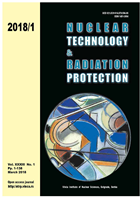
SUITABILITY OF PURE NANO CRYSTALLINE LiF AS A TLD DOSIMETER FOR HIGH DOSE GAMMA RADIATION
Pages: 93-99
Authors: Hany A. Amer, Mostafa M. Elashmawy, Huda A. Alazab, and Mohamed R. Ezz El-DinAbstract
LiF is an alkali halide that is commonly used in radiation dosimetry utilizing its well-known thermoluminescence property. Pure LiF has very limited use in radiation dosimetry since the density and types of the internal traps are limited. For that reason, LiF is usually doped with different elements such as Mg and Ti in (TLD-100) to enhance its thermoluminescence properties and to be suitable for dosimetry applications. In this work we used ball milling as an alternative to dopants (impurities) to induce structure defects (e. g. dislocation) that will play the major role in thermoluminescence process similar to defects caused by dopants. The dislocation density of 1 h ball milled pristine LiF was evaluated at the MCX beamline of the Italian Synchrotron ELETTRA. A ball milled LiF was then compressed in the form of chips, then annealed for 1 h at 600 °C to get rid of low temperature dislocations. The annealed samples showed linear response in the range 50-300 Gy. Fading investigation showed that the integral thermoluminescence intensity almost stabilizes after 12 days from the first irradiation. Results indicate that ball milling is a new promising technique to produce thermoluminescence dosimeters without using any kind of dopants.
Key words: synchrotron radiation, thermoluminescence, LiF,glow curve, ball milling, dislocation, dose response, fading
FULL PAPER IN PDF FORMAT (709 KB)
